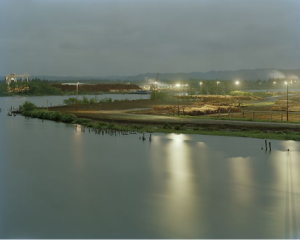Today’s post comes from Lina Kavaliunas, Class of 2013 and Art Center Student Docent.

This spring break I found my way back home to Chicago where I saw the exhibition MCA DNA: Gordon Matta-Clark at the Museum of Contemporary Art. In the 1970s, Gordon Matta-Clark became known for his “anarchitecture” works where he carved out sections of old, abandoned New York buildings, blurring the categories of sculpture and architecture and thus transforming once–dark, used–up spaces into spatial compositions filled with airy pockets of light. These building cuts served as constructive destructions that commented on the static, pro-capitalist methods that Matta-Clark felt marked the architecture of his time. Through the laceration-driven metamorphoses of forgotten concrete and steel structures into new conceptions of space, he bored a hole into the materialistic, excess-driven culture surrounding him and opened up a space that looked towards change.
The exhibition at the MCA presents Matta-Clark’s Circus, or The Caribbean Orange, a work that stands as a perfect display of his challenging “anarchy-architecture” working methods. The MCA invited Matta-Clark to Chicago to use a building adjacent to the museum that was being renovated into additional museum galleries, and so, in February of 1978 the artist arrived and began cutting into the building at 235 East Ontario Street. The resulting work, which was eventually covered up when the renovations took place, was a “curvilinear progression cut through all three stories.”The installation was complex and was supplemented with photographs and drawings that provided a more total conception of the completed work. These series of drawings and photo collages/montages (no straight photography could even attempt to give a full sense of the experience of the work) stand both as a documentation of the original work and as a work on their own—they are the body of the exhibition now on display.
This exhibition at the MCA immediately called another of Matta-Clark’s works to my mind, one that took place not in Chicago but on Vassar’s campus. Seven years earlier, in 1971 Vassar invited Gordon Matta-Clark to Poughkeepsie. The result was Tree Dance, a performance created for the exhibition Twenty-Six by Twenty-Six at the then Vassar College Art Gallery. Tree Dance is not one of Matta-Clark’s “anarchitecture” pieces but rather a work that uses a different, more delicate method to create apertures within static structures. The work involved the suspension of netted, womb-like cocoons and rope ladders from the top of a large tree in front of the Vassar Chapel. Matta-Clark enlisted the help of Vassar dancers who soon found themselves performing Cirque du Soleil-esque acrobatics as they interacted with the vertiginous space. Tree Dance was a temporary work and so the performance was captured on film—creating a work within, or perhaps born out of, the primary work, much like the photo collages that document Circus.
Like the original building in Chicago that became Circus, the tree where Matta-Clark and the Vassar Dance Troupe swung from ladder to ladder, punctuating the calligraphic lines drawn by the branches with slips of movement, is now gone. However, these absences seem to be almost perfect continuations of the works themselves. The originals live on in the works that were born out of their transitory presences and thus live on as traces that call out the necessity for continual transformation. Both Circus and Tree Dance, in their ephemerality, present a resistance to stasis that drives a commitment to progress and to challenging established conceptions and fixed notions of knowledge—a commitment that has marked, and will hopefully continue to mark, the spirit of the Vassar community.





Thrilling post, Lina. I feel like Matta-Clark’s work is especially relevant today, and it’s so exciting to learn about his work at/for Vassar. I feel like we need some more “anarchitecture” in this world that is all about boundaries, about access allowed or denied.
I am particularly struck about Matta’Clark’s work “cutting into the building at 235 East Ontario Street” that created a “curvilinear progression cut through all three stories.” This is awesome. I can’t help but compare it to Carsten Holler’s ridiculous slide cut through the New Museum. Matta-Clark’s work was daring, authentic, and all about transforming the city; Holler’s is about mindless spectacle that does not change anything. We should remember the time when art was about transformation and about opening up radical new possibilities for the city, for people. Exciting and well-written, thank you.